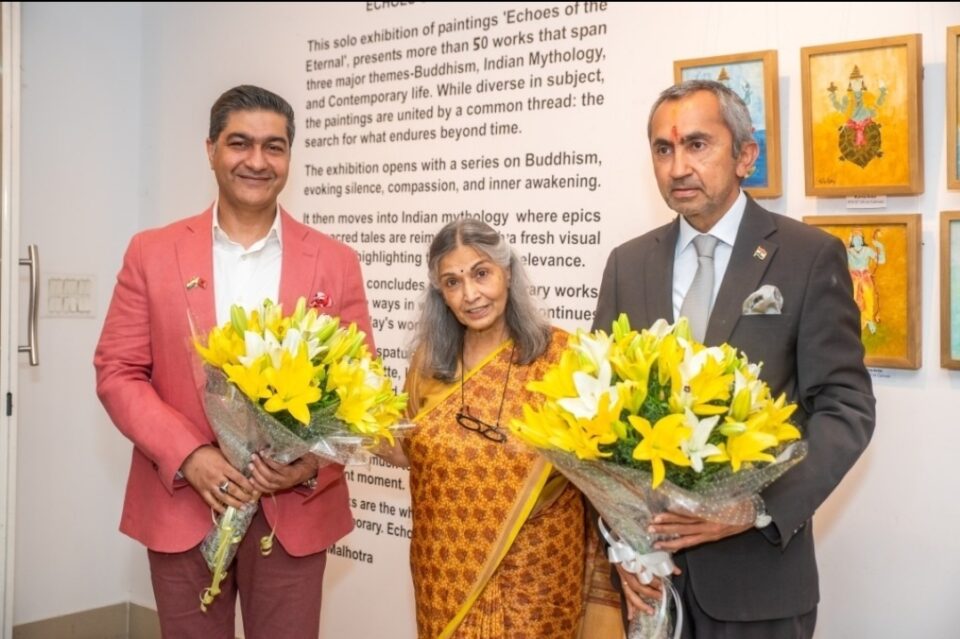Echoes of the Eternal: When Art Teaches CX the Language of Emotion
When visitors stepped into the AIFACS Gallery this October, they didn’t just see art — they felt it. Goldy Malhotra’s exhibition Echoes of the Eternal brought dozens of people together to experience connection beyond time and culture. From serene depictions of Buddha to modern meditations on identity, her work gently invited viewers to slow down and listen — not only to her art but also to themselves.
As customer experience (CX) professionals, this moment holds a striking parallel. In today’s age of automation, empathy and continuity are the “eternal echoes” of experience design. The exhibition’s emotional rhythm — moving seamlessly from Buddhism to mythology to modern reflection — mirrors what brands must strive for: experiences that bridge the sacred and the everyday, the individual and the universal.
Art as a Mirror to Experience Design
Great CX, like great art, isn’t merely consumed; it’s felt. Psychology suggests that art influences visitors through aesthetic emotions — a sensory encounter that stirs memory and meaning. Every color, shape, and symbol triggers an emotional response, creating an immersive connection that outlasts the moment of interaction.
In Malhotra’s words, “We are all seeking connection with that timeless essence.” The same longing exists in brand ecosystems. Customers, whether engaging with a banking app or a wellness brand, seek authenticity and purpose — not just functionality. Behind every digital touchpoint lies a desire for continuity, for experiences that “echo” relevance, trust, and emotional belonging.
Leading galleries, like businesses, have understood that context and curation shape emotional depth. A study on museum experience design notes that carefully sequencing artworks enhances personal reflection, empathy, and connection — principles remarkably similar to the flow a user experiences on a well-designed CX journey map.
The Narrative Thread: Meaning Beyond Moments
In exhibitions, storytelling transforms static collections into living conversations. Visitors move along a narrative arc. Each painting, like each touchpoint in CX, becomes a “chapter” that deepens engagement.
Experience designers can borrow from museum storytelling strategies. According to recent research on exhibition design, stories enhance meaning when they are immersive, linear, and emotionally anchored. They help visitors (or customers) find coherence in complexity — a critical need in today’s fragmented digital environment.
For brands, this means edge-to-edge narrative consistency. Like the curatorial flow of Echoes of the Eternal, CX narratives should make customers feel guided, not marketed to. Think of Apple’s uninterrupted “Explore – Experience – Belong” journey or Airbnb’s seamless “Hosts and Guests” symmetry. Every interaction, visual cue, and message sustains the storyline.
The Spiritual Dimension of Experience
At the heart of Malhotra’s collection lies the meditative practice of seeing beyond oneself. Buddhism teaches detachment from the ego and a deep awareness of impermanence — ideas that resonate strongly with modern experience design. Empathy, presence, and humility underpin both.
The Buddhist notion of anatta — “non-self” — suggests that awareness arises not by asserting identity but by dissolving boundaries. For CX leaders, this translates into a profound design question: Can we create systems that serve customers without centering the brand as the hero? When companies listen, empathize, and co-create, they transform service into shared mindfulness.
Consider the Japanese wabi-sabi aesthetic — finding beauty in imperfection, simplicity, and transience. When integrated into design, it reinforces a human truth: experiences don’t need to be flawless; they need to be real. The warmth of imperfection can humanize even digital journeys, fostering trust through transparency and honesty.
Dikshu Kukreja observed, “Buildings created through centuries in India hold as much art as they do architecture. The theme of Echoes of the Eternal feels especially relevant in today’s world, a world in need of reflection and identity. These works beautifully express that journey, capturing not just artistic mastery but also a search for what defines our culture and heritage.”
Emotion as the Currency of Connection
Marketers often say that emotion drives loyalty, but Goldy Malhotra’s art suggests something deeper — emotion doesn’t just sell, it binds. The strongest customer relationships, like the most powerful art, are built on shared meaning.
Neuroscience supports this. Emotional engagement creates longer memory retention, greater brand preference, and higher advocacy scores. According to industry research, emotionally connected customers are more than twice as valuable as those who are merely satisfied. They buy more, recommend more, and forgive more easily.
This insight parallels the guiding principle of Echoes of the Eternal: continuity emerges from emotional resonance. Whether through storytelling, visual design, or tone, emotion weaves individual experiences into unified brand identities. Brands that evoke calmness, gratitude, or inspiration — the same emotions Malhotra’s art elicits — cultivate loyalty that transcends product cycles.
Designing for Reflection, Not Just Reaction
In a world obsessed with immediacy, modern CX needs moments of stillness. Strategic pauses within journeys — like a reflective artwork in an exhibition corridor — allow people to breathe, feel, and internalize meaning. Emotional pacing can distinguish transactional interfaces from transformational experiences.
Exhibition experts highlight that spatial and emotional rhythm shapes depth of experience. The best exhibitions move visitors from curiosity to immersion, then to reflection. Brands can apply the same rhythm through micro-moments that balance intensity with simplicity — a mindful notification tone, a thoughtful thank-you email, or an onboarding pause that lets users explore rather than rush.
These “silent intervals” in CX design create opportunities for emotional alignment. As in art, silence can speak louder than spectacle.
Continuity as the New Luxury
In experiential design — whether artistic or commercial — continuity builds trust. Malhotra’s exhibition connects Buddhist serenity, mythological depth, and modern reflection through a single invisible thread: timelessness. This same thread differentiates enduring brands from fleeting ones.
Luxury and heritage brands, particularly in post-pandemic markets, have rediscovered the value of temporal continuity. Consumers increasingly seek resonance over novelty. Experience designers thus face a timeless mandate — to anchor experiences in meaning, not merely aesthetics.
Continuity also means coherence across channels. Inconsistent tone or emotion can fracture trust. As in visual art, where every piece complements a larger vision, CX leaders must orchestrate each interaction — from chatbot tone to physical service gestures — to preserve emotional symmetry.
Lessons from Curators for CX Leaders
What can CX professionals learn from curators like those behind Echoes of the Eternal?
- Craft a clear emotional narrative: Define how customers should feel at every stage of their journey. That emotional arc drives memory and loyalty.
- Curate, don’t clutter: Every interaction should contribute meaningfully to the experience — quality over quantity.
- Design for empathy and reflection: Integrate stillness and self-awareness into digital journeys, echoing mindfulness-driven engagement.
- Connect the ancient with the modern: Blend heritage, purpose, and innovation to sustain cultural and emotional continuity.
- Iterate like an artist: Every brushstroke matters — continually refine the tone, pacing, and warmth of experiences.
From Aesthetics to Ethics in Experience
Art exhibitions like Echoes of the Eternal remind us that meaning, not mechanics, sustains relationships. CX leaders must move beyond viewing experience as a metric and embrace it as a moral act — the art of being deeply present for another human being.
Designing ethically responsible experiences requires sensitivity to cultural and emotional diversity. It acknowledges that inclusion is not compliance — it’s compassion. Just as artists appeal to the universal human spirit, organizations must craft experiences that honour perspectives beyond their own — experiences that don’t just satisfy but uplift.

The Takeaway: Echoes That Endure
In the end, Echoes of the Eternal is more than an art exhibition. It is an allegory for the future of customer experience — one that prizes introspection over immediacy, spirituality over speed, and connection over conversion.
CX professionals must learn from artists like Goldy Malhotra, who use beauty to provoke reflection, emotion to foster unity, and continuity to make meaning last. The eternal essence of experience lies not in its novelty, but in its resonance — in the way it lingers, deepens, and reminds us of our shared humanity.
When service becomes art, every interaction becomes an echo of the eternal.

